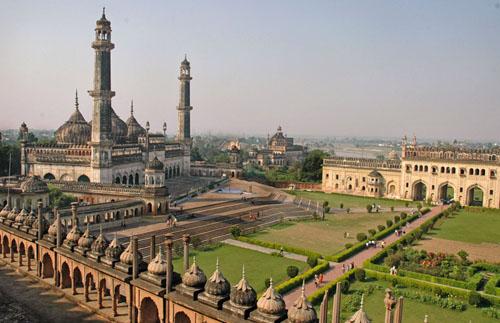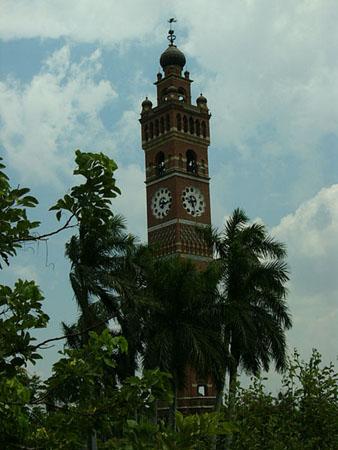Lucknow
The title of ‘the city of Nawabs’ is given to the city of Lucknow, since it used to function as the capital city of the Nawab of Awadh in the ancient times. The city is set on the river beds of Gomti River. The origin of the city can be traced back to the time of the dynasty of the Suryavanshi. Lucknow serves as the capital city of the Indian state of Uttar Pradesh. The Nawab Asafud-Daula established this city.
One can still feel the old appeal of the city although the city of Lucknow has faced enormous development and modernization. The culture of the city is rich because of the reign of the Nawabs. Literature, music, dance and art streams of Lucknow are rich and contain great depth. The origin of the Tabla and Sitar can be traced back to this city. The cuisine of the city is spectacular and finger licking. There are several locations and monuments in the city, which speaks of its glorious past and also reflects the contemporary culture of the city.
PLACES TO SEE
Rumi Darwaza: The Nawab Asafl-us-Daula built the Rumi Darwaza in the year 1786. The altitude of the gate is 60 feet. It is believed that the architectural style of the Rumi Darwaza is similar to that of an archaic gate, which is located in Constantinople.
Asafi Imambara: The Nawab Asaf-ud-Daula constructed the Bara Imambara in the year 1784. In the entire world, the central hall present in the Bara Imambara is believed to be the biggest cryptic chamber. One cannot find any kind of work done in wood in the entire structure expect in the galleries. A string of mazes are present called the Bhool-Bhulaiyan, which can be accessed through a set of steps in the outside. A majestic Asafi Mosque is present in the complex of the Imambara.
Chhota Imambara: The Hussainabad Imambara is located in the west direction of the Bada Imambara. It is commonly known as the Chhota Imambara. Nawab Mohammad Ali Shah constructed this structure during the time period between 1837 and 1842. The structure reflects the Mughal style of architecture in its finest form.
Jama Masjid: In the north-west direction of the Hussainabad Imambara, the Jama Masjid was built. The work for the construction of the Jama Masjid began in the year 1832 A.D., while Mohammad Ali Shah was ruling the region. However, the termination of work on the Masjid was overseen by his begum named Nawab Malika Janah. The Mughal style of design and architecture can be seen reflected from this structure.
Clock Tower & Picture Gallery: The huge Clock Tower is present close to the Rumi Darwaza. The altitude of the tower is a mighty 221 feet. In the year 1887, this structure was built.
Hussainabad Picture Gallery: The construction of this structure was carried out by Nawab Mohammad Ali Shah. It has 12 numbers of doorways. At present, one can see the huge images of the Nawab of Awadh in the gallery.
Shahnajaf Imambara: Located close to the Sikanderbagh and on the embankment of the river Gomti, Ghazi-ud-din Haider constructed this white colored mausoleum. The tombs of Ghazi-ud-din Haider and his three wives are present here.
Residency: During the time period between 1780 and 1800, this structure was constructed for the British people for their dwelling purposes. Initially numerous buildings stood in the big compound. Overseeing the river Gomti, the main building was constructed. Beautiful terraced lawns and gardens encircle this building. A Light and Sound show is hosted here at present.
Shaheed Smarak (Martyrs' Memorial): The monument built in the memory of the martyrs, who sacrificed themselves for the independence of India, is present in a fine looking park on the bed of Gomti River. The memorial has been built in white colored marble.
Dilkusha: In the Gothic style of architecture, the Dilkusha Kothi was constructed. Plush green lawns surround the structure. The Nawab Saadat Ali Khan constructed the Kothi and the superb gardens present beside it.
Lord Human Temples of Aliganj: In the area of Aliganj, one can find two numbers of famous temples of Lord Hanuman. The construction of one of the temple took place in the year 1783 and the second one was built in the year 1798. The queen mother of Nawab Saadat Ali Khan named Chhatar Kunwar constructed these temples.
Charbagh Rrailway Station: As one enters the city of Lucknow, the spectacular architecture of the Charbagh Station invites you in to the city. The very fine elements of the Rajasthani and Mughal architecture are features in the architectural style of the station. The structure has been constructed in the year 1914.
Gurudwara At Yahiyaganj: During the years of 1671 and 1672, Guru Teg Bahadurji and Guru Govind Singhji dwelled here at this Gurudwara. An art gallery is present here. The different events of Sikh Panth are mirrored on the items present in this art gallery.
La Martiniere: In the entire subcontinent, this structure reflects one of the most excellent and biggest specimens of European funerary memorial. Claude Martin, who was a French soldier prior to becoming an architect, planned and designed this structure.
Jain & Buddha Temples: In Lucknow, one can find numerous Jain temples. The Lord Shantinath and Lord Padma Prabhu Temple, which are situated in the Churivali Gali locality, the Lord Parshwanath Temple in Sondhitola, Lord Sambhawnath Temple located in the Phulwali gali (Chowk), five numbers of temples in Dadabari premises at Thakurganj and the Jain temple in Daliganj are the famous temples among the many.
Indira Gandhi Planetarium: One of the main locations of the city of Lucknow, the Indira Gandhi Planetarium is located in the Suraj Kund Park. The shape of the planetarium is done in the shape of Saturn. Excellent art projection system, sound system and a lift ramp are present in the planetarium.
Sikandar Bagh: The name of this structure has been given after the name of one of Nawab Wajid Ali Shah’s begums. The area of the structure is 120 square yards. The mahal is encircled by an altitudinous wall. In the middle of the enclosed area, there is a summer house. Following the independence, the National Botanical Garden was established here.
Chhatar Manzil: Close to the Hanuman Setu, the “Umbrella Palace” is located. The name of the structure has been given so because of the dome, which has an umbrella covering the top. The Nawab Ghazi-ud-din Haider has constructed this architecture. The work of the structure was finished by Nasir-ud-din Haider, his son. At present, the Central Drug Research Institute is present in the campus.
Kukrail Reserve Forest: The Forest Depart of Uttar Pradesh established this location in the exterior regions of Lucknow. One can see a deer park here as well as rare varieties of Crocodiles. Different species of birds can be found here. This location is perfect for carrying out picnic activities. A park for the Children, a cafeteria and a rest house are present within the compounds.
Motilal Nehru Children Museum, Charbagh: This place is apt for the kids between four and fourteen.
Lokkala Sangrahalaya: The Depart of Culture of Uttar Pradesh set up the Lokkala Sangrahalaya. As many as 1600 types of artifact and a very good library are present in the Lokkala Sangrahalaya.
Gandhi Museum: This museum has been constructed with the aim of giving the visitors a glimpse into the life of Mahatma Gandhi. As many as 18,000 numbers of books are present in the collection of the library, which is present inside the museum.
Regional Science City: In the year 1989, the Regional Science Centre has been constructed. It has been buit under the initiative of the National Council of Science Museum. At present, it is called the Regional Science City. Some of the appealing features of this place are the galleries such as the ‘Underwater Exploration Biotechnological Revolution’ and ‘Being Human’, modern facilities such as Scimax Theatre and 3-D Science Show.
Kalagaon (Arts Village), Anora: This place is meant for making people interested towards the village traditions, customs and their life styles. One can get the customary meal called the ‘Jeyee-Leyee’ here. The food is served on the ‘patas’ and the people sit on the ground and eat their food.
Dr. B.R. Ambedkar Samajik Parivartan Sthal: The area covered this region is a whooping 107 acres of land. This place is situated in Gomti Nagar. A monument which has similarities to a Stupa is present in the middle of the large complex. The height of the architecture is 112 feet. It is a statue of Ambedkar, which has been made out of bronze. Some of the attractive features of this location are the Dr. Bhimrao Ambedkar Smarak, Samajik Parivartan Sangrahalaya, Samajik Parivartan Gallery, Pratibimb Sthal, Drishya Sthal, Gautam Buddha Sthal, Samajik Parivartan Stambh, expansive forecourt, Monumental elephant gallery, bronze fountains, Ashokan Columns and urns.
Dr. Bhimrao Ambedkar Gomti Buddha Vihar: The area of the river front covered by the Dr. Bhimrao Ambedkar Gomti Buddha Vihar is 7.5 acres. It a beautiful stretch of river front made in front of the Gomti River having the width of 30 meters and the length of 700 meters. A large figure of the Tathagat Gautam Buddha having the height of 18 feet is present here. It is a marble statue which has four facades.
Samta Mulak Chowk: The architecture of the Samta Mulak Chowk is done in contemporary style. One can observe the grandiose figures of personalities such as Chhatrapati Shahuji Maharaj, Sant Narayan Guru and Mahatma Jyotiba Rao Phule. These statues have been made in black stone. The land-scapes that are designed and created here are quite mesmerizing.
Dr. Bhimrao Ambedkar Gomti Vihar: On the southern bank of the river named Gomti, the area named Gomti Vihar has been established. The area of the land covered by this location is 90 acres. This place is a perfect place in order to relax and take a walk and to carry out picnic activities.
Dr. Ambedkar Gomti Park: The area of the land covered by the park is 22 acres. Numerous people come here to see the beautiful environment and the humungous fountain.
Manyawar Kanshiram Memorial: The amount of land covered by the Manyawar Kanshiram Memorial is 86 acres. The altitudinous cupola of the structure is having a diameter of 125 feet. The altitude of the memorial is a whooping 177 feet. Some of the characteristic features of this location are the huge elephant figures, the murals made of bronze, the bronze statues, the galleries, granite columns, the inscriptions on the memorial, the beautiful widespread gardens and the altitudinous bronze fountains.
Bauddha Vihar Shanti Upvan: The distance of the Bauddha Vihar Shanti Upvan from the Charbagh Railway Station is a mere 5 Kms. The amount of land covered by this location is as much as 32.5 acres. One can get mesmerized by the spectacular architecture of the structure. The building has been constructed with sand-stone.
Manyawar Shri Kanshiram Ji Green (Eco) Garden (Mskjgeg): The new Manyawar Shri Kanshiram Ji Green Garden is located beside the Manyawa Kanshiram Memorial. The land covered by this garden is 112 acres.
Smriti Upvan: The Smriti Upvan is located close to the Baudha Vihar Shanti Upvan, just across to the Bijli Pasi Quila. The land covered by this architecture is 11 acres. The structure has been constructed with granite as well as sand-stone.
HOW TO REACH LUCKNOW
By Air: The Chaudhary Charan Singh Aiport in Lucknow is connected to all the major cities of India.
By Rail: Lucknow has got its very own major railway junction.
By Road: Lucknow has got well connected road links to all the major locations in India.








